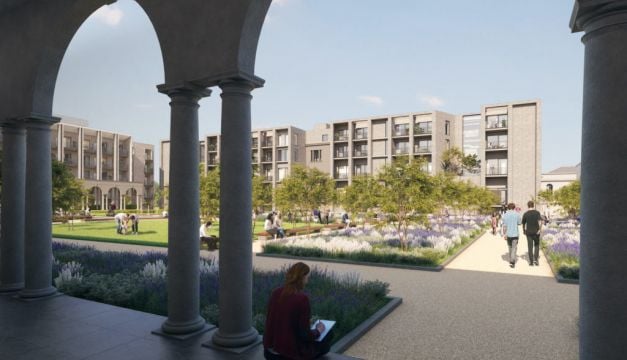A developer’s bid to save its planning permission for 1,593 rental apartments in north Dublin’s inner suburbs has been rejected by the Supreme Court.
A partner fund of developer Hines received fast-track approval in November 2021 for the highly contentious €602 million scheme of 12 blocks, including one of 18 storeys, on the site of the former Holy Cross seminary on Clonliffe Road in Drumcondra.
The Supreme Court on Thursday upheld the High Court’s decision to strike down the approval, granted under a now-extinct fast-track process, in a challenge brought by Fionnuala Sherwin, a resident of Knocksinna Grove, Foxrock, south Co Dublin, who describes herself as a practising Catholic.
Her case was against An Bord Pleanála, which did not seek to appeal the judgment itself but was supportive of the developer’s application.
Ruling for the five-judge Supreme Court, Mr Justice Séamus Woulfe said An Bord Pleanála’s inspector did not properly assess whether the proposed development would cause harm to the curtilage of adjacent protected structures on the site.
Dublin City Council’s conservation officer recommended refusing planning permission, saying the height, scale and massing of the 18-storey block was “excessive in this context‚ and will entirely dominate and seriously injure the architectural setting of the protected structures”: the former seminary and the 18th-century Fortick’s Alms House, known as the Red House.
The officer recommended omitting the tower from the development as he felt this block would injure the surrounding environs of Drumcondra and would be “clearly visible in long-range views from other parts of the historic city”.
The board’s inspector considered the 18-floor building could sit side by side with existing protected structures without detriment.
However, Mr Justice Woulfe was satisfied that this opinion cannot be viewed as an assessment of compliance with the development plan’s policy for protected structures.
The judge said there was no assessment of whether the tower, whose height is significantly above those permitted by the Dublin City Development Plan, would “relate to and complement” the special character of the protected structure.
The permission fell in the top court for different reasons than in the High Court. Its ultimate undoing was the board’s failure to consider relevant provisions of the local development plan, said Mr Justice Woulfe.
While the board’s inspector noted concerns raised by the council’s conservation officer regarding the potential impact a proposed basement could have on mature trees on the grounds, she did not refer at all to the relevant policy in the local development plan, said the judge.
Therefore, he said, she failed to assess whether a grant of planning permission would contravene the local plan’s policy of discouraging basement development next to protected structures, particularly having regard to potential effects on mature trees.
The court was also not satisfied that the board properly expressed its reasoning for its decision. The adequacy of its reasons must be tested in light of the “overwhelmingly negative view” of the council’s conservation officer and of the relevant Government department on important aspects of the project, the judge said.
The contentious build-to-rent development posed by the developer (CWTC Multi-Family ICAV) attracted more than 120 submissions, including from Sinn Féin leader Mary Lou McDonald, who stated that approval would only exacerbate the housing crisis.
Mr Justice Woulfe’s ruling was supported by Supreme Court colleagues Mr Justice Peter Charleton, Ms Justice Iseult O’Malley and Mr Justice Brian Murray.







